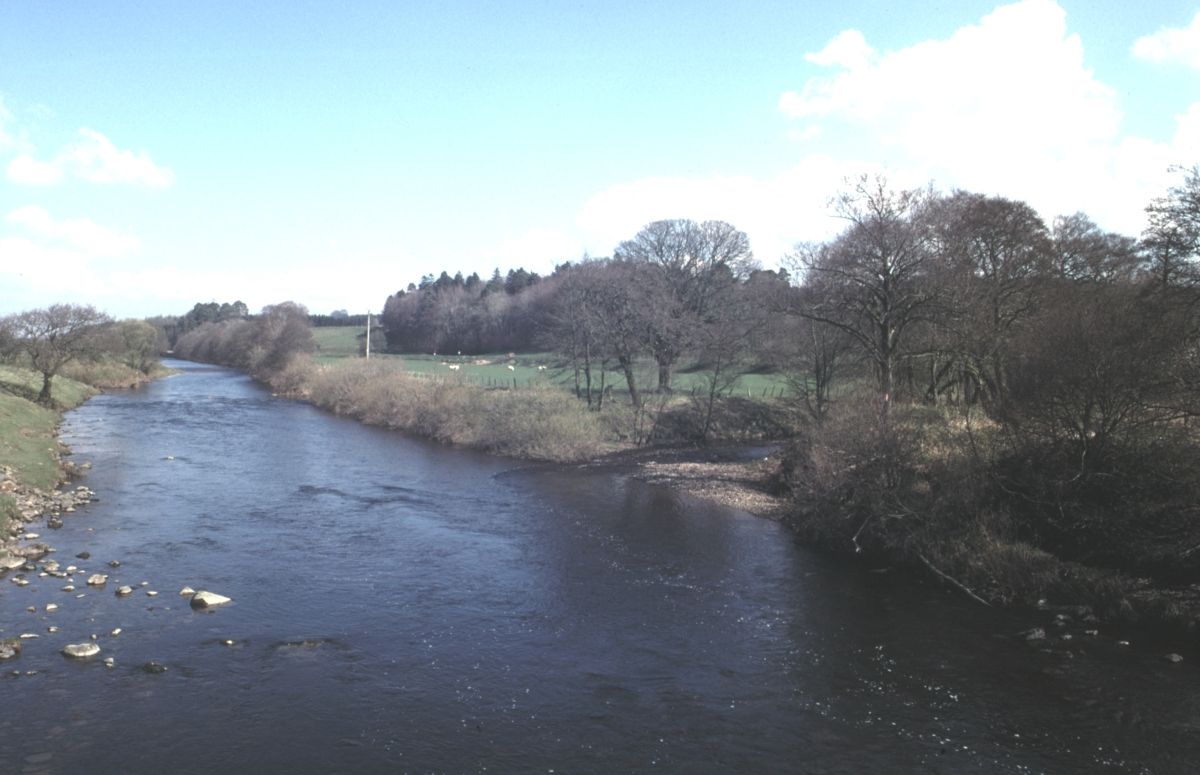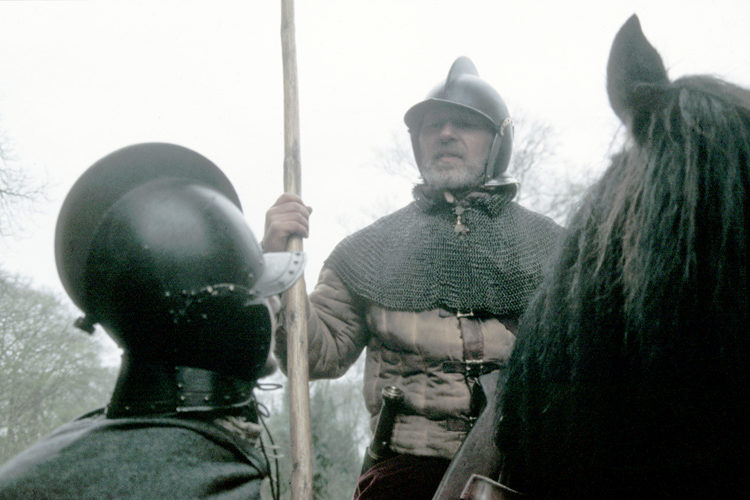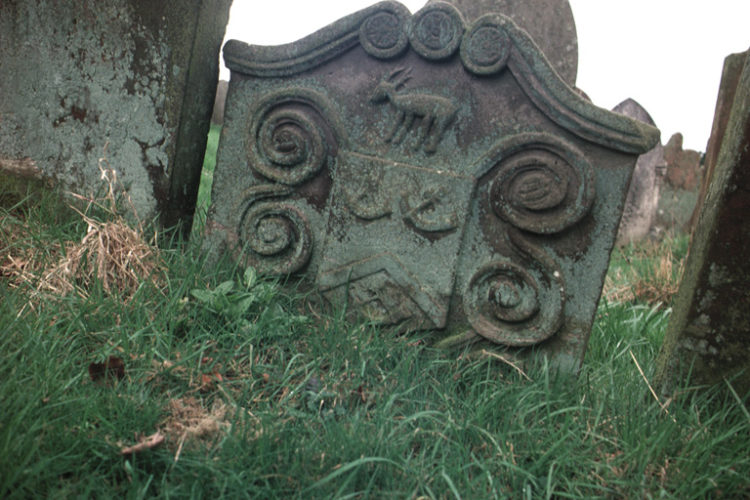The 'Peaceful Persuasion' And Transplanting Of The Marchmen By James VI Scotland & I England/Scotland…
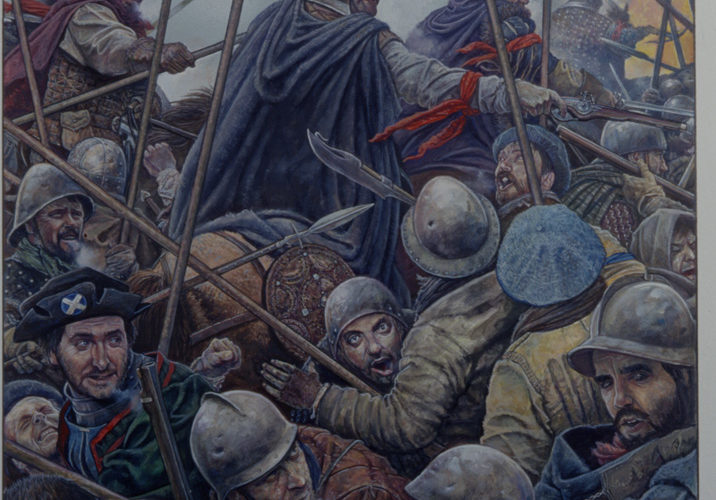
Clothing armour weapons of Border Reivers
Clothing armour weapons of Border Reivers
Clothing
The inventory for Ewanrigg Hall in 1585 shows the relative value of clothing; a leather jacket had the same value as much as the best horse of a wealthy man. An account from the period describes how armed men would steal the clothing from travellers, and a bale of fine cloth would be a highly valued booty. The inventory of the Selkirk widow lists some of the fine clothes and cloth used at that time. Men would adorn functional fighting clothing with fine under shirts.
A jack or brigandean
The Reiver is wearing what is called a jack or brigandean. It is a protective jacket which was worn as an alternative to plate armour or to chain mail. It has the great advantage of being light and flexible and still affords the wear a fair degree of protection against a sword thrust or lance thrust but much less protection from an arrow or a bullet.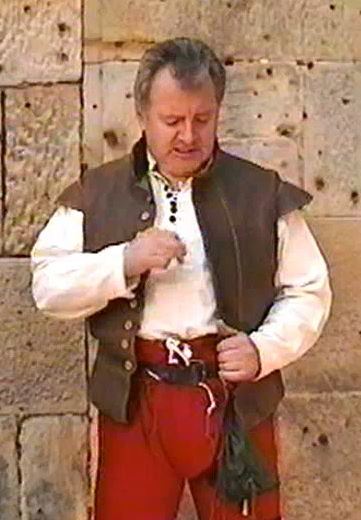
Some of these garments had metal or horn plates which are sown into the lining between the inner and outer face thus providing the wearer with an extra layer of protection.
The jack was a lot cheaper to make and manufacture than a metal protective plate. The jack would usually have wooden or leather buttons, with very heavy duty stitching down the seams and along the lining. The high neck on the jack is there not just as a fashion, but is there to protect the wearer against sword thrusts or cuts to the back or side of the neck and to the throat.
The Reiver is wearing a copy based on one in the National Museum of Scotland. It dates from about 1575 to 1585. This form of protection of some sort or another was worn right through out the medieval period and worn in the civil war times.
The jack had many advantages over metal armour. It was a lot cheaper to make and manufacture than a metal garment. It was light and thus was easier for the Reiver and his horse to carry. The material was readily available locally and could be made with local tools and skills.
The flexibility of the jack allows the user to move easily which meant that he could wear it in his normal work yet have its protection in a fight. The jack would usually have wooden or leather buttons, with very heavy duty stitching down the seams and along the lining. The high neck on the jack is there not just as a fashion, but is there to protect the wearer against sword thrusts or cuts to the back or side of the neck and to the throat. The Reiver is wearing a copy based on one in the National Museum of Scotland. It dates from about 1575 to 1585.
The jack was not only a protection against blows but was also a protection against the cold wet weather of the border country. The high neck on the jack is there not just as a fashion, but is there to protect the wearer against sword thrusts or cuts to the back or side of the neck and to the throat. Another record shows a reiver in a woollen jacket who wears a metal gorget to protect his neck. The neck was a crucial area to defend because a side blow to one arm still allowed the other arm to use a weapon, but a side blow to the neck was likely to instantly incapacitate and be fatal.
This particular example is based on a copy in the National Museum of Scotland. It dates from about 1575 to 1585. This form of protection of some sort or another was worn right through out the medieval period and worn in the civil war times. Similar designs are seen on the foot soldiers of most of the European armies at this time.
The cost of the jack is very hard to give because they were made locally by the family or wearer himself. The cost to make it would quite literally be no more than the amount of leather used to make it, which would come from one the beasts from the herds of the family or wearer.
However the value given to the jack can be seen in the record for the inventory of Ewanrigg Hall in Cumbria which values a jack as having the same price as his best horse – the equivalent value of a family saloon car. A Reiver would be unlikely to afford more than one jack and this would suffice for all work and war occasions.
cost of armour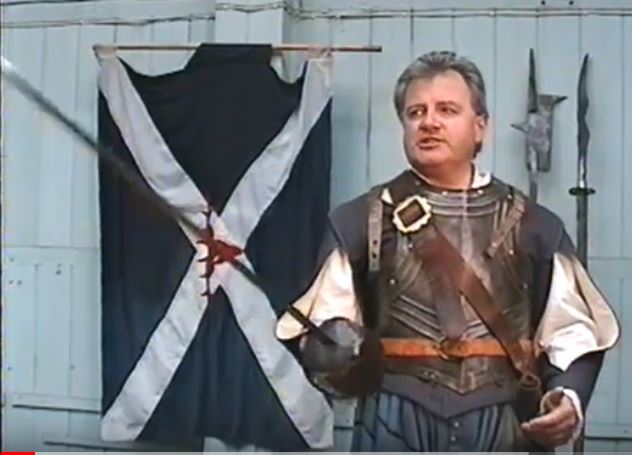
Plate armour at these times were extremely expensive. A full plate armour, although they were no longer worn for battle in the late sixteenth century, they were still worn for the tournament. In comparative terms a full plate of armour could cost in modern day prices £20 000 or £30 000, the cost of an expensive motor car. The cost of a jack to be manufactured was small, though the value then given to the finished piece was high.
The actor is representing an english gentleman farmer in the North of England, Northumbria, in the late sixteenth century. This actor is taking is name of Herron. Herron is a well known border name. They were from time to time Wardens of the Middle March and also notorious reivers when not performing official duties. The Reiver is wearing an outfit that might have been worn when reiving cattle from his Scottish neighbours. For body protection the Reiver is wearing a jack or brigandene, a leather protective jacket.
Underneath that, the Reiver has on a linen shirt, which has wooden buttons and is locally handmade.
The Reiver has a stout leather belt which supports a leather pouch. In his pouch the Reiver would keep basic food stuffs, a few coins and things of that nature. If the Reiver had a firearm he would also keep his shot in his pouch.
The Reiver has on a pair of hose which are close fitting woollen breeches with a cod piece held in place by leather thongs; buttons were expensive and difficult to replace.
On his legs and feet the Reiver is wearing horseman’s boots. These are stout leather boots which extend half way up the thigh. These enable him to ride all night without the stirrup leathers chaffing on his legs and also protected the legs against thorn bushes..
The boots also would provide a certain level of protection against sword cuts. The leather of the boots like the leather of the jack would provide some protection from a slash from an enemy sword or axe.
English farmer
The actor is representing an English gentleman farmer in Northumbria in the late sixteenth century. This Reiver is taking is name of Herran, a well-known border clan who were from time to time Wardens of the Middle March and also notorious Reivers in their own right.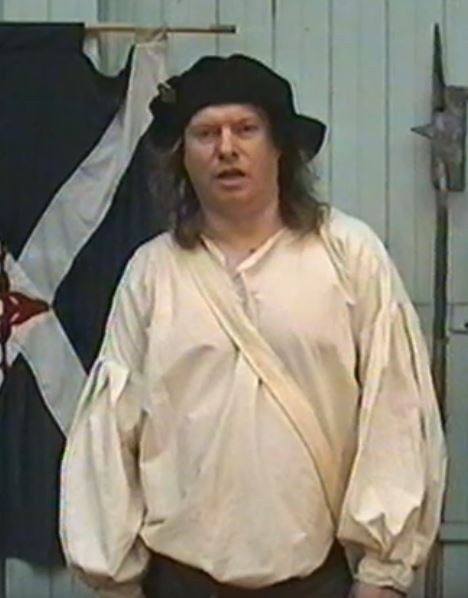
It was not unknown for officials to undertake raids either for their own profit or to continue a feud. Even during the period known as the Pacification of The Borders, the Commissioners complained that the Captain of Bewcastle had married his daughter to a well known local Reiver.
The Reiver is wearing an outfit that might have been worn to go out and steel cattle from his Scottish neighbours about this time. In the way of bodily protection the Reiver is wearing what is called a jack or brigandene, a leather protective jacket. The Reiver has on a linen shirt, which has wooden buttons and is locally handmade.
Pouch
The Border Reiver did not have pockets in his clothing and would tend to carry items in a purse called a “Shot Pouch” which was suspended from a belt around his waist. In the shot pouch he might carry a few coins or if he carried a firearm he would carry the powder and shot in it.
It would be made of leather and since it was carried around his waste, it could be tucked inside the breeches to keep the powder dry and warm. When he needed to fill the gun he could quickly take it from under his breeches, load the weapon then tuck the pouch back into the weather protection inside his breeches.
Trousers cod piece
The actor has on a pair of hose, which would nowadays be called trousers. Hose are close fitting woollen breeches, which has a cod piece, a separate flap of material, held in place by leather thongs.
Horsemans boots
On his legs and feet the Reiver is wearing horseman’s boots. These are stout leather boots which extend half way up the thigh. These enable him to ride all night without the stirrup leathers chaffing on his legs and also protected the legs against thorn bushes..
The boots also would provide a certain level of protection against sword cuts. The leather of the boots like the leather of the jack would provide some protection from a slash from an enemy sword or axe.
The breeches the Farmer is wearing are made of heavy thick wool. The Farmer, in the field, needed breeches which were very durable and weatherproof. Therefore naturally oiled wool like this example were extremely resistant to the driving rain and wind.
The Reiver also has a cod piece which is held up by small leather laces. Although the item has a fashion element, it was a practical arrangement of his clothing. Buttons were expensive to make and highly impractical to re-sew in the field. The construction of trousers with button flies has great complexity where seams of the legs and the crutch meet.
A simple flap around the crutch allows for a simple construction and a simple method of relieving oneself. Although these breeches have a thick leather belt, many would be joined by laces to the upper undergarment which meant that no belt was necessary and also meant there was no chance of shirt and trouser separating which would cause heat loss.
buttons
The buttons on the farmer’s garment are made of wood though sometimes buttons were made of bone and occasionally of metal. The button holes themselves are very carefully worked into the lining of the garment with a leather flap so that when the Reiver fastens his jack, the buttons are not visible. This arrangement provides protection against the weather , so rain did not run down through the button holes. The flap also provided protection against enemy swords; an enemy sword would be more likely to glance off the face off his jack, then catch on the buttons and be guided through the flap to the wearer’s body.
SWORDS
The Reivers were rural workers who occasionally committed acts of great violence. They were not wealthy nor were they well educated. Their weapons had to be either used in their daily life, or needed to be made from the same materials and techniques that created their normal tools.
Local metal technology was not very sophisticated and the metal axe that cut wood could shatter when clashed against another metal blade. So when sword blades hit, they had to be tough and strong and the best specialised blades were made abroad. They were too expensive for the ordinary Reiver to purchase and even wealthy families had swords that were passed down generations. The sword thus had deeds of valour and violence told of it.
Main gauche
The opponent is going to lunge with his rapier sword and the Reiver will catch the rapier with his “main gauche” (left hand) dagger, which in partnership with the sword formed the ‘pair of arms’.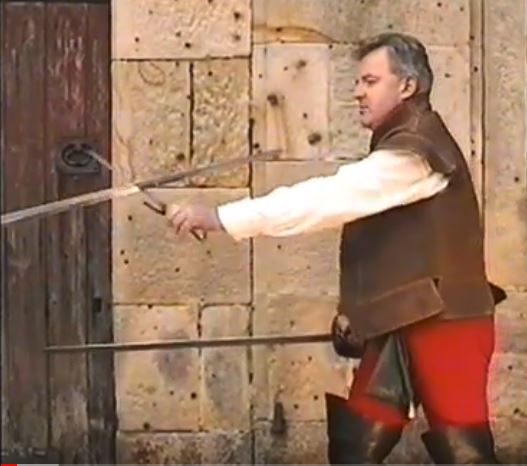
The Reiver traps his opponent’s blade, so the blade is caught in the fork of the dagger’s hilt. This hilt is specifically designed, for catching the blade and if the dagger is twisted properly it can break the opponent’s blade. Even if the blade is not broken, the attacker’s weapon is no longer a threat and a counter blow (riposte) can be made on the attacker.
Dagger riposte
The Reiver’s opponent is going to lunge at him with his rapier sword and the Reiver will catch the rapier with his main gauche (left-hand) dagger, his defensive dagger, which in partnership with the sword formed the ‘pair of arms’. His opponents sword is then locked into the fork of the Reivers hilt. The Reiver then twists his blade in an attempt to break it. Once the Reiver traps his attacker’s blade, he would then lunge in riposte at his attacker’s unprotected side.
on guard position
The on guard position is the stance which the fighter would take up when he is about to engage in combat. The Reiver here is stood with his legs fairly flexible, one foot in front of the other, ready to lunge or to parry as the occasion demands.
rapier sword
This is a modern facsimile of a late sixteenth century rapier. A rapier was a sword normally carried by a gentleman. They were rather expensive to manufacture, much more so then the typically caveraly or foot soldiers back sword. The blades were usually manufactured in France or in Italy or Germany. Many of them bearing the name Andrea Ferrara. The hilts were themselves often made abroad or by local indigenous local hilt makers. The whole weapon is a much lighter addition than the earlier medieval broad sword.
It is primarily intended for thrusting as opposed to slashing. It is a much more precision tool than the medieval broad sword, which appears as a bludgeon by comparison. The rapier came into fashion when duelling began itself to become fashionable on the continent in the early sixteenth century, with the abandonment of armour and gentlemen settling their quarrels with rapiers and main gauche daggers.
The blade is made of tempered steel and the rapier here is quite short. On some rapiers the blade could be as much as a yard (90 cm) or 40 inches (100 cm) long. Fencing and duelling became enormously fashionable and dangerous throughout the course of the sixteenth century.
A number of fencing masters set up schools in London and other large cities throughout Europe, teaching gentlemen how to handle themselves and their weapons.
The Italians for much of the sixteenth century led the way. The Italian masters devised a particularly offensive form of fencing depending almost entirely upon the thrust using very long bladed and hardened rapiers aiming for the throat and the neck and the face aiming to kill at any point.
The English masters, more particularly George Silver who was right in the very late sixteenth century, the 1590’s , preferred a hybrid style of fencing, with a mixture of offensive and defensive moves.
We see this particularly well illustrated in the theatre at the time. If one looks at the stage directions for the fight scenes in Romeo and Juliet, you will note that Tibelt being the assassin type of character that he is naturally prefers the ultra aggressive Italian style whereas Romeo fights with the English style and wins.
intro to rapier
This is a modern facsimile of a late sixteenth century rapier. A rapier was a sword normally carried by a gentleman. They were rather expensive to manufacture, much more so then the typically caveraly or foot soldiers back sword.
The blades were usually manufactured in France or in Italy or Germany. Many of them bearing the name Andrea Ferrara. The hilts were themselves often made abroad or by local indigenous local hilt makers. The whole weapon is a much lighter addition than the earlier medieval broad sword.
It is primarily intended for thrusting as opposed to slashing. It is a much more precision tool than the medieval broad sword, which appears as a bludgeon by comparison. The rapier came into fashion when duelling began itself to become fashionable on the continent in the early sixteenth century, with the abandonment of armour and gentlemen settling their quarrels with rapiers and main gauche daggers.
In the sixteenth century armour became less used and swords became lighter and their use changed from the swinging axe like blow to the quick and accurate thrust to the vital areas of the opponent. The blade is made of tempered steel and the rapier here is quite short. On some rapiers the blade could be as much as a yard (90 cm) or 40 inches (100 cm) long because in a thrusting fight, the longest weapon had an advantage.
Heavy armour of the early medieval period meant that heavy weapons had to be used to chop through the armour. The Reiver did not have the option of heavy armour which was expensive and heavy. He needed to travel fast and travel with minimum weight on small horses over marsh and bog. The distance travelled on a reiving night became part of folklore of the area.
The usual victim of the Reiver would be an unarmed or lightly armed farmer or his farm workers. The light rapier suited this lifestyle when he used a sword. Often he would use other light effective weapons such as a jeddart axe or if he was on horse, he would use a long light lance known as a “pricker”. Other records show models by Pete Armstrong of this gear.
The Italians
Brute force and energy powered the broadsword but technique and style made effective use of the light rapier and tuition and practice became essential. Fencing and duelling became enormously fashionable and dangerous throughout the course of the sixteenth century.
A number of fencing masters set up schools in London and other large cities throughout Europe, teaching gentlemen how to handle themselves and their weapons. The Italians for much of the sixteenth century led the way.
The Italian masters devised a particularly offensive form of fencing depending almost entirely upon the thrust using very long bladed and hardened rapiers aiming for the throat and the neck and the face aiming to kill at any point.
The English
Brute force and energy powered the broadsword but technique and style made more effective use of the light rapier and thus tuition and practice became required to use the rapier. Fencing and duelling became enormously fashionable and dangerous throughout the course of the sixteenth century.
A number of fencing masters set up schools in London and other large cities throughout Europe, teaching gentlemen how to handle themselves and their weapons.
The English masters, more particularly George Silver who was right in the very late sixteenth century, the 1590’s , preferred a hybrid style of fencing, with a mixture of offensive and defensive moves.
Romeo & Tibelt
Brute force and energy powered the broadsword but technique and style made more effective use of the light rapier and thus tuition and practice became required to use the rapier. A number of fencing masters set up schools in London and other large cities throughout Europe, teaching gentlemen how to handle themselves and their weapons.
The Italians for much of the sixteenth century led the way. The Italian masters devised a particularly offensive form of fencing depending almost entirely upon the thrust using very long bladed and hardened rapiers aiming for the throat and the neck and the face aiming to kill at any point. The English masters, more particularly George Silver who was right in the very late sixteenth century, the 1590’s , preferred a hybrid style of fencing, with a mixture of offensive and defensive moves.
We see this particularly well illustrated in the theatre at the time. If one looks at the stage directions for the fight scenes in Romeo and Juliet, you will note that Tibelt being the assassin type of character that he is naturally prefers the ultra aggressive Italian style whereas Romeo fights with the English style and wins.
Back sword
This is a more rudimentary form of sword, it is a back sword. The back sword was a type of weapon that would be carried by most Border Reivers throughout the later part of sixteenth century. It is in some ways a cruder weapon then the rapier, though it was particularly designed to be used by a man on horseback.
It is refered to as the back sword because only one edge, the leading edge side of the blade is sharpened. The reverse side of the blade is not sharpened at all and the weapon was then intended for the downward cut from the horseman.
These weapons were made often manufactured with blades which were imported from either Italy or Germany. In this case the blade has been imported from Italy and bears the name Andrea Ferrara.
In addition to having the makers name on the reverse of the blade, Andrea Ferra, it also has the name of the man who had the blade made for him. In this case it was for a member of the Douglas clan , ?? Douglas Mcfatet which in latin would translate as Douglas had me made. The blade also has the manufacture date and the sigh from the sword smith.
The hilt of the weapon is a lot more basic than the rapier. It has a simple wooden handle with a basket or cage hilt which is made crudely and manufactured by the local smiths. It does however provide complete protect for the hand. The pommel of the sword serves as a counter weight and balance which is quite handy if you decide to shove the blade in the opponents face.
An altogether cruder weapon then the rapier, but typical of those carried by Border Reivers. Some of these weapons had a more intricate basket or Irish hilt Despite there rather clumsy appearance they were actually quite light.
The rudimentary form of sword called a back sword was a type of weapon that would be carried by most Border Reivers throughout the later part of sixteenth century.
The rudimentary form of sword called a back sword was a type of weapon that would be carried by most Border Reivers throughout the later part of sixteenth century. It is in some ways a cruder weapon then the rapier, though it was particularly designed to be used by a man on horseback.
It is referred to as the back sword because only one edge, the leading edge of the blade is sharpened. The reverse edge of the blade is not sharpened at all and the weapon was then intended for the downward cut from the horseman.
These weapons were made often manufactured with blades which were imported from either Italy or Germany. In this case the blade has been imported from Italy and bears the name Andrea Ferrara. In addition to having the makers name on the reverse of the blade, Andrea Ferra, it also has the name of the man who had the blade made for him. In this case it was for a member of the Douglas clan.
He has engraved his name Ultheric Douglas Manfatet which in latin would translate as Douglas had me made. The blade also has the manufacture date and the sigh from the sword smith such as the Running Wolf of Soligen.
The hilt of the weapon is a lot more basic than the rapier. It has a simple wooden handle with a basket or cage hilt which is made crudely and manufactured by the local smiths. It does however provide complete protect for the hand.
The pommel of the sword serves as a counter weight and balance which is quite handy if you decide to shove the blade or the hilt in the opponents face. An altogether cruder weapon then the rapier, but typical of those carried by Border Reivers. Some of these weapons had a more intricate basket or Irish hilt
Despite there rather clumsy appearance they were actually quite light and this allowed the thrusting and parrying actions to be used that were used with the rapier. It was slightly heavier than the rapier and thus contained more energy in its swinging blow from a mounted horseman.
Hand and a Half sword
This is a hand and a half sword. It is referred to as a hand and a half sword because it could be used one handed or it could be used with both hands. The grip on the double handed sword has one hand on the pommel and the other on the handle thus allowing maximum flexibility and movement and also would add weight to the downward blow
This type of sword was staring to go out of fashion in the course of the sixteenth century, but was still carried by a number of foot soldiers and the Scots carried on using similar hand and a half swords right through into the seventeenth century and were using them through the civil war period and the campaigns of Montrose.
How these swords were made involved for the standards at the time a very high level of technology. The blades were patterned by the metal constantly being heated, folded, beaten, refolded and beaten again. This process continued until the steel that was finally produced was very very fine, it was very light in weight and also very strong and flexible in terms of the amount of wear and tear it would sustain.
A good well made sword,, if it wasn’t lost or somehow broken in battle, could last for several generations. Weapons were often handed down from father to son.
From a very early time in the Middle Ages, the idea of sword bearing was linked to the status of a gentleman and to the status of chivalry and knighthood.
When a man was to be knighted, he would have the sword with him in the church and the sword would be blessed by the church as part of his status, and as part of his approved armoury of knighthood. The sword was just a weapon it was very much a badge of rank and office.
Swords often acquired personalities of their own. In the medieval period and the sixteenth century people were very superstitious, so a man would give his sword a name and invest it with characteristics.
The sword even though it ceased to be used as a weapon of war by the nineteenth century, still survives today as a badge of rank among officer cadets at Sandhurst on ceremonial occasions.
Weapons like the one the Reiver is holding, in the sixteenth century were definitely used for real.
This is a hand and a half sword. It is referred to as a hand and a half sword because it could be used one handed of it could be used with both hands. The grip on the double handed sword was used with one hand on the pommel to create maximum flexibility and movement and also would add weight to the downward blow.
This is a hand and a half sword. This type of sword was staring to go out of fashion in the course of the sixteenth century, but was still carried by a number of foot soldiers and the Scots carried on using similar hand and a half swords right through into the seventeenth century and were using them through the civil war period and the campaigns of Montrose.
This is a hand and a half sword. The manufacture of these swords involved a very high level of technology for the standards of the time. The blades were patterned by the metal constantly being heated, folded, beaten, refolded and beaten again.
This process continued until the steel that was finally produced was very fine, it was very light in weight and also very strong and flexible in terms of the amount of wear and tear it would sustain.
A good well made sword,, if it wasn’t lost or somehow broken in battle, could last for several generations. Weapons were often handed down from father to son.
From a very early time in the middle ages, the idea of sword bearing was linked to the status of a gentleman and to the status of chivalry and knighthood.
When a man was to be knighted, he would have the sword with him in the church and the sword would be blessed by the church as part of his status, and as part of his approved armoury of knighthood. The sword was not just a weapon it was very much a badge of rank and office.
Swords often acquired personalities of their own. In the medieval period and the sixteenth century people were very superstitious, so a man would give his sword a name and invest it with characteristics.
The sword even though it ceased to be used as a weapon of war by the nineteenth century, still survives today as a badge of rank among officer cadets at Sandhurst on ceremonial occasions. Weapons like the one the Reiver is holding, in the sixteenth century were definitely used for real.
This blade is inlaid with a Latin inscription, which was put on by the sword smith at the order of the owner. The sword was not a mass-produced product, swords were made and customised for the needs of the wearer. There is Latin inscription inlaid into the blade and in good sixteenth century tradition the Latin is miss spelt. This blade is inlaid with the armourer’s mark, on both sides and also on one side of the blade, the name of the owner is inlaid with his mark and his name in Latin .
Battle Axe
The Reivers were rural workers who also committed acts of great violence on occasion. They were not wealthy nor were well educated. Their weapons had to be either used in their daily life, or needed to be made from the same materials and techniques that created their normal tools. An axe would be familiar to them and the addition of spikes converted it from a wood chopping tool to a person killing weapon.
This is a battle axe. Weapons like this were used through out the Viking period to the end of the sixteenth century. The battle axe was popular with fighters both on horse and foot. They were particularly effective weapons against armoured opponents because of the weight that could be put into the swing.
There was the famous incidence at the battle of Bannock Burn where King Robert the Bruce mounted upon his horse engaged in combat with a fully armoured English knight Sir Humphrey De Bohun. During the course of the fight the King brought the blade of his axe down upon the crown of the Englishman’s helmet and split him, as Shakespeare would have said from the nave to the chops. That was the end of Sir Humphrey De Bohun.
Weapons like this were enormously effective in hand to hand combat and very popular though the Border Reiver Period. Not only did the weapon have an axe blade, it had a point which could be used for penetrating opponents armour and it also had a spike on the far end which could be used to administer a coup de gras to the back of the neck; a very affective weapon.
Many of the corpses found in the mass graves from the Battle of Towton , which was fought on Palm Sunday in 1461, bore evidence of wounds from weapons of this kind to the head or back of the neck . It was obvious most of them were killed by weapons of this sort rather than a sword or other weapon. Weapons like this were used through out the Viking period to the end of the sixteenth century. The battle axe was popular with fighters both on horse and foot.
The battle axe was a particularly effective weapons against armoured opponents because of the weight that could be put into the swing. There was the famous incidence at the battle of Bannock Burn where King Robert the Bruce mounted upon his horse engaged in combat with a fully armoured English knight Sir Humphrey De Bohun. During the course of the fight the King brought the blade of his axe down upon the crown of the Englishman’s helmet and split him, as Shakespeare would have said from the nave to the chops. That was the end of Sir Humphrey De Bohun.
